Chum salmon in the SRKW range
By Mikaela Gerwing
Summary:
We look at data for Chum salmon in six major regions of the Southern Resident Killer Whales (SRKW) range, and also Fitz Hugh Sound, an important part of Northern Resident Killer Whales (NRKW) range. We use and synthesize data from the Pacific Fisheries Resource Conservation Council, the Pacific Salmon Commission Joint Chum Technical Committee, the Department of Fisheries and Oceans Canada, and the Washington Department of Fish and Wildlife. We find publicly available Chum escapement data in these regions to be seriously limited in recent years; some datasets extend to 2005 and the most recent only extends to 2013. Such limited data do not allow us to establish robust correlations between Chum salmon escapement levels and the decline of the SRKW. In the data presented we find that in the SRKW range most salmon stocks remain close to historical averages. Stocks in the West Coast of Vancouver Island and Queen Charlotte Sound (As well as Fitz Hugh sound for the NRKW), have declined overall since the 1980s. Recent trends in these populations are unknown.[1]
Why Chum salmon?
Both SRKW and NRKW primarily feed on Chinook salmon (Oncorhynchus tshawytscha) but are also known to consume both chum (Oncorhynchu keta) and coho (Oncorhynchu kisutch) at certain times of the year (COSEWIC, 2018). We’ve been examining historical data of Chum salmon stocks in the areas that the Southern and Northern residents frequent to better understand how the salmon are doing. We have access to annual Chum salmon escapement data from the 1980s.
Escapement:
Escapement refers to the exact or approximated number of fish that return to the stream or river where they were born in order to spawn (Pacific Salmon Commission, 2016). We have collected salmon escapement data from seven primary regions where the resident killer whales are found; the Georgia Strait, Johnstone Strait, the Strait of Juan de Fuca, Puget Sound, the West coast of Vancouver Island, the Fitz Hugh Sound, and Queen Charlotte Sound. Escapement data from the Pacific Salmon Commission was collected by estimating derivations of both swim and aerial surveys, counting fences, carcass studies and most recently through Area-Under-the-Curve (AUC) methodology (Pacific Salmon Commission, 2017). Escapement estimates from the Washington Department of Fish and Wildlife were derived from hatchery escapement live counts annually, calculated using AUC (Washington Department of Fish and Wildlife, 2018.) Escapement data from both Van Will et al., (2009) and Spilsted and Pestal (2009) was derived from counting fences, sonar technology, and visual surveys on foot or via helicopter and was calculated using AUC. Escapement data from Labelle (2009) was derived from the Department of Fisheries and Oceans Canada through visual observation, counting fences and mark-recapture operations.
Georgia Strait:
Both SRKW and NRKW are found in and around the Georgia Strait (COSEWIC, 2008). Georgia Strait Chum escapement has increased since 1980 and when last recorded in 2005, sits at a level just below that of escapement between 1990 and 1995. A trend of rapid increases closely followed by sharp drops in escapement normalizes the trends seen. The most current data recorded was in 2005, more recent numbers were unavailable.
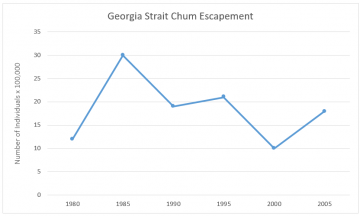
Data retrieved from: Labelle, 2009.
Johnstone Strait:
Both SRKW and NRKW are found in and around Johnstone Strait. Johnstone Strait Chum escapement seems to follow a pattern of sharp increases immediately followed by a large drop after 1990. After a sharp decrease in escapement between 1990 and 2000, the increase between 2000 and 2005 is promising, however, as the most current data recorded was in 2005, more recent trends are unknown.
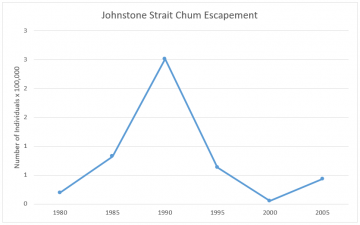
Data retrieved from: Van Will et al., 2009.
Strait of Juan de Fuca:
Both SRKW and NRKW are found in and around the Strait of Juan de Fuca. Strait of Juan de Fuca Chum escapement was at a similar level in 2012, as it was in 1980. The trend follows steep decreases, followed after a period of time by sharp increases in escapement. The most recent data between 2010 and 2012 shows a decline. Both summer and fall escapement levels are similar, the major difference being a longer period of low levels of escapement for summer stocks between 1985 and 2000 than that of fall stocks.
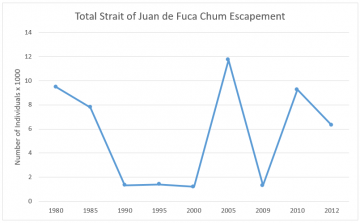
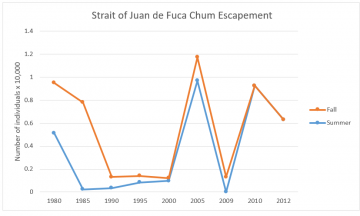
Data retrieved from: Washington Department of Fish and Wildlife, 2009.
Puget Sound:
Only SRKW are found in Puget Sound. Puget Sound Chum were at a nearly identical level of escapement when the most recent data was recorded in 2009 as they were in 1980. Trends consistently show increases in escapement followed by decreases over periods of around five years. While the most recent data between 2005 and 2009 show a decline, it seems to be in line with trends since 1980. Winter and fall stocks seems to follow a nearly identical pattern, while summer stocks have seen a significant increase in escapement between 1980 and 2009.
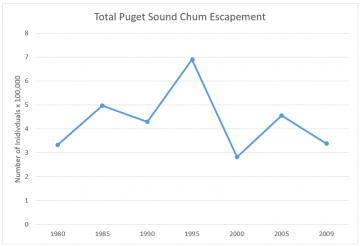
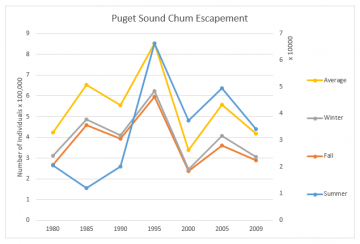
Data retrieved from: Pacific Salmon Commission Joint Chum Technical Committee, 2018.
West Coast of Vancouver Island:
Both SRKW and NRKW are found around the West Coast of Vancouver Island. Data for chum escapement on the West Coast of Vancouver Island is limited to that between 2004 and 2013. This data shows an overall decreasing trend since 2004, but a levelling off of the decline between 2010 and 2013. All four rivers analyzed show a similar level of decline, but with Nootka River experiencing a slightly more significant decrease in escapement since 2004.
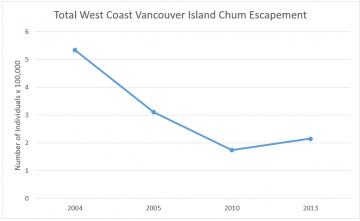
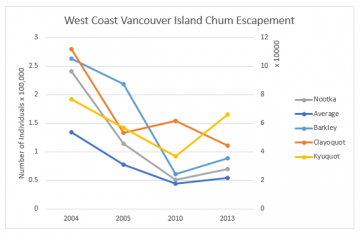
Data retrieved from: Pacific Salmon Commission Joint Chum Technical Committee, 2018.
Fitz Hugh Sound:
Only NRKW are found in and around Fitz Hugh Sound. Chum escapement in Fitz Hugh Sound has seen a significant decline between 1980 and the most recent available data in 2005. Escapement levels were consistent between 1980 and 1995, followed by a rapid decline from 1995 to 2000. This significant decline was followed by a steep increase between 2000 and 2005, but not enough to sustain similar levels of escapement as seen between 1980 and 1995.
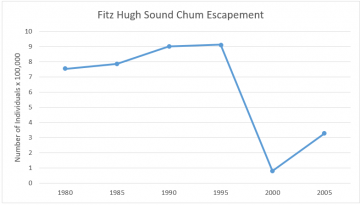
Data retrieved from: Spilsted and Pestal, 2009.
Queen Charlotte Sound:
Both SRKW and NRKW are found in and around Queen Charlotte Sound. Chum escapement in the Queen Charlotte Sound has seen an overall significant decline between 1980 and the most recent available data in 2005. Despite a steep decrease in escapement between 2000 and 2005, chum escapement seems to be following historical trends of increases followed by decreases over the period of approximately five years, as seen since 1980.
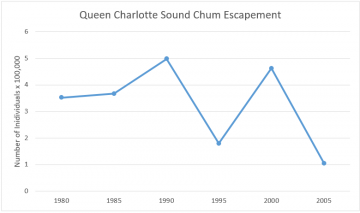
Data retrieved from: Spilsted and Pestal, 2009.
If you’re interested in learning more about our SRKW and NRKW or their primary prey Chinook salmon, check out our last two blogs and stay tuned to learn about their tertiary prey Coho salmon coming soon.
References:
Labelle, M. 2009. Status of Pacific Salmon Resources in Southern British Columbia and the Fraser River Basin. Pacific Fisheries Resource Conservation Council.
Pacific Salmon Commission. (2016). FAQs. Retrieved from: https://www.psc.org/about-us/history-purpose/faqs/
Pacific Salmon Commission Joint Chum Technical Committee. 2018. 2014 Post Season Summary Report. TCCUM (18)-01.
Spilsted, B. and Pestal, G. 2009. Canadian Manuscript Report of Fisheries and Aquatic Sciences 2879. Fisheries and Aquaculture Management Branch.
Van Will, P., Brahniuk, R., Hop Wo, L., and Pestal, G. 2009. Certification Unit Profile: Inner South Coast Chum Salmon (Excluding Fraser River). Canadian Manuscript Report of Fisheries and Aquatic Sciences 2876.
Washington Department of Fish and Wildlife. 2018. Puget Sound Chum Salmon Information and Databases. Retrieved from: https://wdfw.wa.gov/fishing/salmon/chum/pugetsound/data.html
[1] Our data and references used are limited, therefore should not be taken as conclusive, but as suggestive. Data used in this review was compiled from available open-access sources, and does not offer a complete insight into salmon stocks of all rivers in the SRKW and NRKW ranges. Our data does not include changes in seasonal distribution, water quality or other determinants of fish availability.